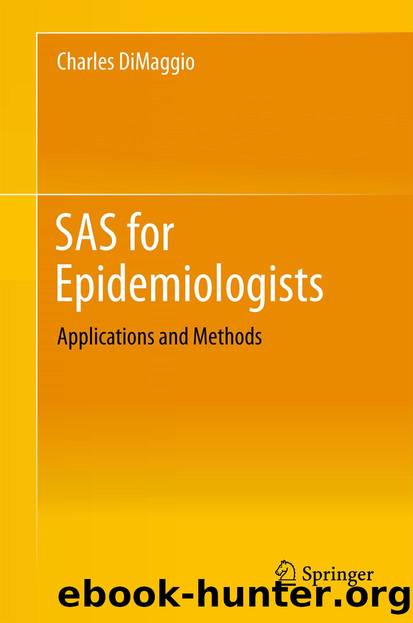SAS for Epidemiologists by Charles DiMaggio

Author:Charles DiMaggio
Language: eng
Format: epub
Publisher: Springer New York, New York, NY
9.4.1 Identifying and Controlling Confounding
If there is, in fact, some third variable accounting for an apparent effect of our exposure variable on our outcome variable, we will want to identify and account for its effects. Classically, comparing the unadjusted (or crude) measure of effect to the adjusted (or stratified) measure of effect is the key to assessing for confounding. This is best illustrated by an example.
Consider the following data on the effect of coffee drinking on myocardial infarction:
The odds ratio is Does this indicate an apparent causal effect of coffee drinking on myocardial infarction? In addition to the critical questions of temporality (did coffee drinking precede MI or perhaps folks who have survived an MI tend to drink coffee?) biological plausibility, existing literature on the subject, etc., we must ask: Are there any known risk factors for myocardial infarction that might be associated with drinking coffee? The answer is yes: smoking.3 It meets the a priori definition of a confounder in that it is causally related to the disease, associated with the exposure, and not a mediator of the exposure disease relationship. Lets look at the data for evidence of a confounding effect. MI
No MI
Download
This site does not store any files on its server. We only index and link to content provided by other sites. Please contact the content providers to delete copyright contents if any and email us, we'll remove relevant links or contents immediately.
| Cell Biology | Developmental Biology |
| Entomology | Marine Biology |
| Microbiology | Molecular Biology |
| Biostatistics |
Sapiens: A Brief History of Humankind by Yuval Noah Harari(13037)
The Tidewater Tales by John Barth(12026)
Do No Harm Stories of Life, Death and Brain Surgery by Henry Marsh(6332)
Mastermind: How to Think Like Sherlock Holmes by Maria Konnikova(6224)
The Thirst by Nesbo Jo(5778)
Why We Sleep: Unlocking the Power of Sleep and Dreams by Matthew Walker(5636)
Sapiens by Yuval Noah Harari(4528)
Life 3.0: Being Human in the Age of Artificial Intelligence by Tegmark Max(4492)
The Longevity Diet by Valter Longo(4443)
The Rules Do Not Apply by Ariel Levy(3897)
The Immortal Life of Henrietta Lacks by Rebecca Skloot(3820)
The Body: A Guide for Occupants by Bill Bryson(3789)
Why We Sleep by Matthew Walker(3767)
Animal Frequency by Melissa Alvarez(3750)
Yoga Anatomy by Kaminoff Leslie(3696)
Barron's AP Biology by Goldberg M.S. Deborah T(3628)
The Hacking of the American Mind by Robert H. Lustig(3575)
All Creatures Great and Small by James Herriot(3506)
Yoga Anatomy by Leslie Kaminoff & Amy Matthews(3392)
